
Welcome back! In this issue of ChildrensLit Now, we’ll walk in the shoes of an illustrator and learn about books that are changing the way teachers create and present lessons. Of course, step into a few new book reviews that are sure to motivate you to visit the bookstore or your local library. We’re starting to fly through 2021, and all the books you’ll learn about in this issue will warm your heart during one of the coldest, snowiest, iciest months in history.
Shelley Oakley
Director, Children’s Literature
Subscribe to ChildrensLit Now Newsletter
In case, if you have missed our previous issue.
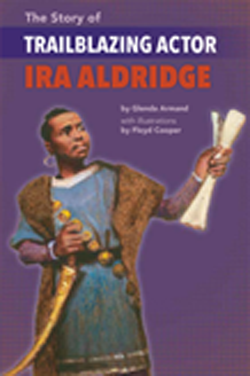
Asked about African American leaders, American students probably think first of such historical figures as Martin Luther King, Jr., and Rosa Parks. However, there are many other African American leaders who have been left out of school lessons and therefore unrecognized for their work. This text is a first step towards changing that, at least for the story of Ira Aldridge. This child-friendly biography lays out Ira Aldridge’s life in the form of a narrative story.
The balance of text and nonfiction text features, such as images, captions, bold words, a timeline, and a glossary, supports younger readers who are transitioning into more informative reading. This book has been adapted from a picture book, and it would be the perfect addition to a themed set of texts which would provide a differentiated reading experience for more advanced readers. This text highlights Aldridge’s life in a well-rounded way, enabling readers to learn about Aldridge the boy who loved theater, Aldridge the actor who lived Shakespeare’s words, Aldridge the dreamer who forged his own path, and Aldridge the gifted performer who inspired audiences.
It is extremely important for readers to experience texts that act as mirrors and allow children to see themselves reflected in the stories they read, and this book functions effectively as a mirror for young boys, especially African American boys. Just as essential are texts that act as windows into other people’s experiences, to build empathy and understanding for others. This book will function effectively for all children in that way. This book would be a perfect addition to any upper elementary classroom.
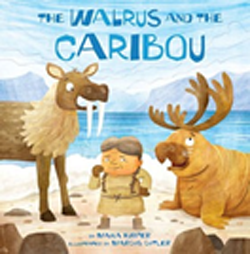
Long ago, when the world was still being formed, a woman named Guk breathed life into a walrus and a caribou. Her original designs didn't work out quite the way she hoped, but it's hard to get it all right on the first try! Through experience, she gains new ideas about how to "fix" the animals, revealing how they came to look the way they do today. Harper has created a playful retelling of a traditional folktale from the Inuit North. The text is sparse but lively and accompanied by charming, humorous illustrations.
The author's introduction to her connection with Inuit folktales adds a personal touch that reminds readers of the importance of folktales and serves as a great conversation starter. A short but welcoming glossary provides a pronunciation guide to the Inuit words found in the story, giving readers another way to connect with the Inuit culture. Overall, this is a quick, playful read, perfect for reluctant readers and those who enjoy creation stories. Recommended.
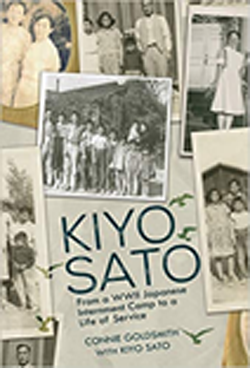
Kiyo Sato’s story opens on her last night of freedom in February 1942. Ever since the Japanese Air Force bombed Pearl Harbor on December 8, 1941, Kiyo has felt shunned by her fellow college students. Now, against the urging of his wife Eleanor, President Roosevelt has ordered that all people with one-sixteenth or more of Japanese heritage must leave the West Coast, specifically the states of California, Oregon, and Washington. They must abandon their home, work, and daily life; they are only allowed to take one suitcase of belongings each.
As Kiyo helps her seven younger brothers and sisters pack, her mother anxiously prepares food for the journey to nowhere and cleans the house for their return. Little do they know that they will not return for years, that their father will have to sell some of his land at low prices, and that his prized tractor will disappear during the war years. Nor do they expect that their house will be occupied by a single mother and her children when they return home in 1945, after three years of incarceration.
Author Connie Goldsmith, a writing colleague of Kiyo Sato’s, traces the arc of her life as a young student and Nisei (American son or daughter born to Japanese immigrant) at the beginning of WWII through her life in internment camps in California and Arizona to her role as a prominent speaker on the history of the American internment of United States citizens of Japanese heritage and the loss of their property and rights during and after the war. Throughout the book, Goldsmith emphasizes the strong values shared by Kiyo and her siblings, six of whom served in the U.S. military. Kiyo served as a nurse in the Korean War and then found work as a school nurse. With their parents, the children cleaned up their neglected farm and house and returned to the farming business their family had started. However, even as a student in college, Kiyo discovered that telling her story was a way to share aspects of American history unknown to many Americans. Restoring that hidden history became her avocation. This book continues her work, by bringing her story to a wider audience of young teens. Recommended for school and public libraries, as well as classes in American history and leadership.
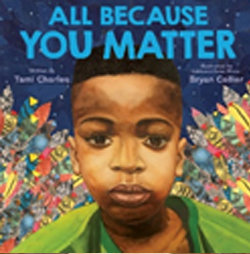
Follow a young Black boy through his early years with this loving and lyrical tale. Here is a reassurance of one's worth and importance simply for being who you are, regardless of the sound of your name or the color of your skin. The story reads as a love letter from a parent to a child. Here, the parent tells the child that he matters because matter is made of all things in the universe, including energy, stars, and space. The child was dreamt of by ancestors who came before him. The child is affirmed that when he was born the sky was full of light, hope, and love. First steps, first words, first books for the child are celebrated here. Yes, life can be challenging at times, such as when the child does not feel seen or struggles with an assignment at school. Life can seem even more challenging when racial injustices happen and police brutality takes the lives of people with similar skin color. The child is reminded that despite those atrocities, he matters and always will. This is a truly beautiful love letter to young black and brown children that all should read and hold true. The illustrations are bold and compelling, being colorful and inspired by a quilt-like effect. This is a "must-have" for any home or classroom with young children.
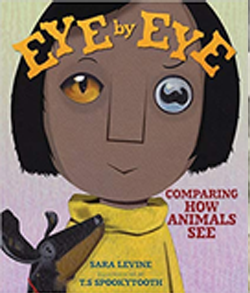
Author Levine and illustrator Spookytooth introduce children to the different ways eyes function in a variety of animals. The narrative is framed as a series of wonderings, as a diverse group of children imagine what life would look like through the eyes of several different animals. A freckled girl with glasses imagines seeing the world through eight eyes, like a spider. A girl in a headscarf is pictured viewing the world like a starfish, through six eyes on the ends of six arms. Some imagine seeing through eyes with different shaped pupils, such as those of horses, cats, and snakes; others imagine seeing different colors, in the manner of dogs, birds, and butterflies. Levine often explains why scientists think these differences exist, and the advantages they give to different animals.
Some, though, could use more information. For example, how does having eight eyes help a spider? What are the advantages of having immovable eyes like an owl? Spookytooth’s acrylic illustrations help children visualize each difference by showing how it would look on a human. The hand-lettered font may be a little challenging for new readers, but it combines with the bold lettering of the questions and the illustrations of animals and children to create a visually interesting spread. The back matter includes some activities for “seeing” like other animals, a glossary, and a list of books and websites for more information. Readers would probably appreciate more detailed information about some of the animals discussed in the narrative, but this is an intriguing concept book that will whet children’s interest.

A puppet master uses a dangerous power to secure a place aboard a royal ship for an audience with a king rumored to have a spring that cures all ills. Inspired by Asian cultures and French colonialism.
When I saw illustrator Vivian Mineker’s illustrations for Robert Frost’s The Road Not Taken (Familius), the book took on a very vivid meaning for me. Vivian’s talent in using color and depth truly made the woods feel as big as the decision the boy must make at the fork in the road.
I had the pleasure of interviewing Vivian in 2019. After the interview and seeing other books Vivian illustrated, I knew if ever I decided to put imagination to paper, she would be the first illustrator I would seek out. Fast forward to revamping our ChildrensLit website. Our team wanted illustrations that personified what ChildrensLit is all about- how books open up young imaginations no matter where one is or where one chooses to read. I knew, without hesitation, that I wanted Vivian to create the ChildrensLit world. She did. As you can see in the illustrations in our newsletters and on our website and social media pages, Vivian captures the joy of reading. She encapsulates how a child can get wrapped up in a story no matter the location, how a family can enjoy stories together, and the power of oneself entering the story.
We often hear about an author's struggles and challenges but less so of those of an illustrator. Vivian spoke with me again, but this time the conversation was about the life of an illustrator. I hope you enjoy this look into the life of a children’s book illustrator, and if you are a budding illustrator, will find answers to some of your questions.
Shelley Oakley
Director, ChildrenLit Review Source

The Illustrator’s Life
Many aspiring illustrators picture themselves spending their days collaborating with authors on books all day long, all months of the year. What has the reality been for you?
Vivian: When I first started out, I definitely spent a large portion of my time doing everything I needed to promote myself, which includes creating my own projects to add to my portfolio, making and updating my website and social media, as well as sending out emails and postcards periodically to publishers and potential agencies. As I started to get more work, naturally more time was spent working on books and various projects. Recently I’ve had quite a lot of projects, so I’d say I’ve been spending only about 10-15% of my time on everything that is not drawing — replying to emails, printing/shipping products, sending invoices, etc. The rest is creating illustrations.
What are some misconceptions people have about illustrators?
Vivian: I think a lot of people think that because we draw/paint, it’s a very relaxing job. While it is super fun and rewarding, it definitely has its tough moments. I had prepared to work hard before I started because I’ve heard from some of my illustrator friends that it could get crazy, but I was still overwhelmed when it happened. There have been periods where I felt suffocated by the crushing amount of work and the little amount of time I had to get it all done. Sometimes I would work 14-16 hours a day and still barely catching up! However, this is definitely not all the time; it just happens from time to time. It’s a side of the job that I don’t think many people expect when they think about illustrators.
What has been the preferred author/illustrator collaboration by publishers? Who decides on illustration edits- you, the author, or the publisher?
Vivian: Every illustrator has his/her preference on this. For me, I’ve found that a good and detailed brief by the publisher really helps at the beginning. It gives me a good starting point when they’ve laid out their vision and a general direction they’d like to see the book going, and from there, I would do a few sample drawings and character designs. It’s super helpful and saves a lot of time to start off on the same page. After that, I like to have the freedom to explore my own ideas and come back to the publishers for feedback. In short, I like to have a common starting point with the publisher and author, then go off on my own without too much instruction since my work always turns out much better when I feel free to imagine and explore.
What are some of the biggest challenges/hurdles you have faced as an illustrator thus far?
Vivian: As an illustrator, the biggest challenge for me has always been coming up with the best image for the text. And sometimes there is just no inspiration or good ideas; I’d spend hours and hours struggling to come up with something. Especially when I’ve been working on client/paid work for a while without doing any personal art, I find my creativity goes way down. I feel myself going stale and nothing interesting comes into my head, and my work started to become quite boring and predictable. So now I make sure I leave time for personal art as a reset for me and a little palate cleanser for my creativity.
On the practical side, I’ve had a hard time managing my schedule. I had a full-time office job before becoming an illustrator, so I was not used to being a freelancer, especially the part where the income isn’t consistent. And as a beginner, I was so grateful to have any work at all; I said yes to everything. After a while, the projects piled up, and I became overwhelmed and couldn’t devote enough time and energy to one project. There were a few things that I did that I wish I’d had more time to spend on, but it was just not possible with the amount of work I had. So now I’ve learned to turn down some work so I can have more focus on the projects I have.
What are the pros and cons of having an agent?
Vivian: I’ve generally had a positive experience with my agency. Since I signed with an agent pretty early on in my career, they’ve been super helpful in terms of exposure for me. I was able to get work with clients that I would’ve otherwise not been able to reach, or it would’ve taken a lot more time. To have the experience of working with larger publishers really helped me develop my portfolio. They’ve also taught me a lot of little things about the etiquette and quirks of the industry, saving me from making mistakes that I would’ve on my own. Overall, it just feels nice to have someone who’s got your back and on your side working with me towards my career goals.
The most obvious drawback is the commission fee. Depending on the agency, they take between 20-30% of the fee from each project. But on the other hand, they do increase the amount of work I’ve been able to get and negotiate higher rates than I would’ve done, so I think it’s more than fair. Another thing that had confused me in the past was whether I could still have my own clients. Sometimes clients reach out to me directly without knowing I had an agent, so in that case, I had to really look into the agency’s policy on that. Each agency is different, so you just have to make sure you read the contract carefully and understand everything to avoid any awkward incidents.
Best advice for budding illustrators?
Vivian: Find your own voice! In illustration terms, your own style. There are so many great and successful illustrators out there, and one of the most important qualities they possess is that they have a unique style. It’s something that is not like anyone else’s, and it’s recognizable from a mile away. There is no shortcut to developing that style. It takes A LOT of trial and error. You just have to keep drawing until the style/voice comes to you and sticks. I had a hundred totally different styles before I found the one I have now. Just keep drawing, draw everything you like and try everything, eventually you’ll evolve into your own artistic identity.
Another thing is just to work hard. There is no quick and easy way to become a good artist. You have to draw all the time and work harder than others to get to your goal. Illustration is a competitive industry. There are SO many talented people out there, so you can’t just take it easy and expect work to magically appear. Put yourself out there as much as you can, make any contact you can find, go to book fairs and conventions, meet with any publisher/agent that would meet with you, and keep creating new work.
Lastly, have faith and keep on going. If you’ve got good work, a positive attitude, and are persistent, magical things will happen!
Visit Vivian’s website for more information about her and her work: https://www.vivianmineker.com/
The Outstanding Works of Literature Award (OWL)
The Outstanding Works of Literature Award, also known as the OWL Award, is sponsored by BookPal. This award started in 2017 and has three award categories with five subcategories. According to BookPal, “The Outstanding Works of Literature (OWL) Award highlights titles that are changing the way organizations do business, educators create and teach curriculum, and communities understand and pursue well-being.” Children's and YA books mainly qualify under the Education category, with the following subcategories: Picture Books, Elementary, Middle School, High School, and Advanced Reading. We really like the concept and purpose of this award. It provides a meaningful way to look at literature and its impact on our world. This award is certainly one to watch over the next decade. https://bookpal.com/owl-award
2020 Education Award Winners
Picture Books: I Am Every Good Thing by Derrick Barnes and illustrated by Gordon C. James
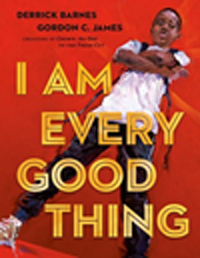
The confident Black narrator of this book is proud of everything that makes him who he is. He's got big plans, and no doubt he'll see them through--as he's creative, adventurous, smart, funny, and a good friend. Sometimes he falls, but he always gets back up. And other times, he's afraid because he's so often misunderstood and called what he is not. So slow down and really look and listen when somebody tells you--and shows you--who they are. There are superheroes in our midst!
2020 Education Award Winners
Elementary: Tune It Out by Jamie Sumner

Twelve-year-old Lou Montgomery's life has been centered on her mother's terrifying plan to make her a singing star, but a crisis reveals Lou's sensory processing disorder and people determined to help her address it.
2020 Education Award Winners
Middle School: When Stars Are Scattered by Victoria Jamieson and Omar Mohamed
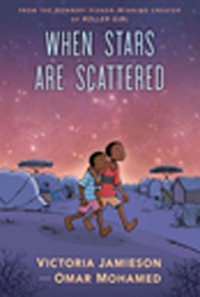
Omar and his younger brother Hassan live in a refugee camp, and when an opportunity for Omar to get an education comes along, he must decide between going to school every day or caring for his nonverbal brother in this intimate and touching portrayal of family and daily life in a refugee camp.
2020 Education Award Winners
High School: We Are Not Free by Traci Chee
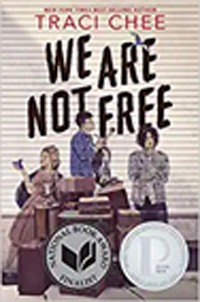
The collective account of a tight-knit group of young Nisei, second-generation Japanese American citizens, whose lives are irrevocably changed by the mass U.S. incarcerations of World War II. Fourteen teens who have grown up together in Japantown, San Francisco. Fourteen teens who form a community and a family, as interconnected as they are conflicted. Fourteen teens whose lives are turned upside down when over 100,000 people of Japanese ancestry are removed from their homes and forced into desolate incarceration camps. In a world that seems determined to hate them, these young Nisei must rally together as racism and injustice threaten to pull them apart.
2020 Education Award Winners
Advanced Reading: Transcendent Kingdom by Yaa Gyasi
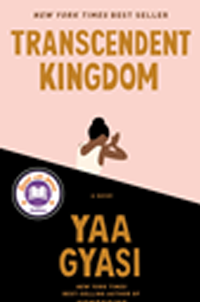
Gifty is a sixth-year PhD candidate in neuroscience at the Stanford University School of Medicine studying reward-seeking behavior in mice and the neural circuits of depression and addiction. Her brother, Nana, was a gifted high school athlete who died of a heroin overdose after an ankle injury left him hooked on OxyContin. Her suicidal mother is living in her bed. Gifty is determined to discover the scientific basis for the suffering she sees all around her. But even as she turns to the hard sciences to unlock the mystery of her family's loss, she finds herself hungering for her childhood faith and grappling with the evangelical church in which she was raised, whose promise of salvation remains as tantalizing as it is elusive. Transcendent Kingdom is a deeply moving portrait of a family of Ghanaian immigrants ravaged by depression and addiction and grief--a novel about faith, science, religion, love.
★ This year marks the 35th anniversary of the Ezra Jack Keats Award and ChildrensLit Now plans to bring you all the information you need to know about the spring celebration to honor Keats’ legacy.
Our April newsletter will provide detailed information about the celebration including the silent auction of original children's book illustrations, the new documentary about Ezra Jack Keats’ impact on the evolution of diversity in American children’s literature, and other ways you can participate in the celebration.
Until then, don’t miss the 2021 Ezra Jack Keats Awards Announcement on March 9, 2021.
For information on how to host a Mock EJK award and more, visit https://www.ezra-jack-keats.org/award-35th-anniversary/
★ ChildrensLit reviewers come from a broad background of people who work with kids and teens. We continue to secure reviewers who have a unique set of experiences and skills, and this month we are recruiting special education teachers and reading specialists. Special education teachers provide insight into how a book may benefit students with special challenges or unique learning styles. Reading specialists can dig deep into the book’s plot and the author’s writing style to provide a review beneficial not only to language arts teachers but also to general teachers.
If you are a special education teacher or reading specialist, please visit https://www.childrenslit.com/becomeareviewer to sign up.
★ ChildrensLit has revamped its website with beautiful illustrations. Check out how illustrator Vivian Mineker created our ChildrensLit world at www.childrenslit.com.